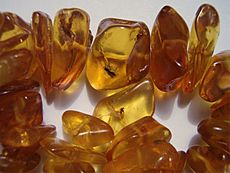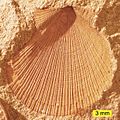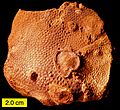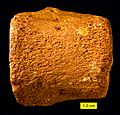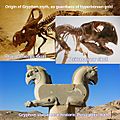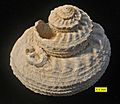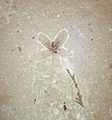Fossil facts for kids
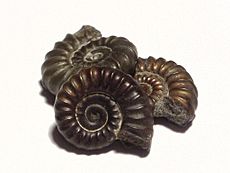
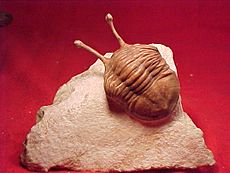
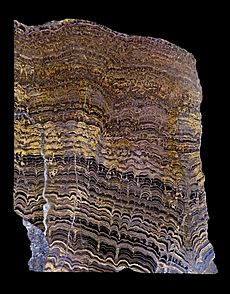
A fossil is the remains or trace of an ancient living thing.
Fossils of animals, plants or protists occur in sedimentary rock.
In a typical fossil, the body form is retained, but the original molecules that made up the body have been replaced by some inorganic material, such as calcium carbonate (CaCO3) or silica (SiO2). The fossil feels like, and is, made of rock. It has been mineralised or petrified (literally, turned into rock).
A fossil may also be an imprint or impression of a living thing remaining in the fossilised mud of a long-gone age.
Some organisms fossilise well, others do not. The most common fossils are those left behind by organisms that produce hard materials. The hard, calcitic shells of molluscs (such as clams and snails) and of now-rare brachiopods (also known as lampshells) are examples. These sea-dwelling shellfish have produced many fossiliferous (that is, fossil-bearing) chalky layers of limestone in the earth.
Soft-bodied organisms can fossilise in special circumstances: the Ediacaran biota is a good example.
The best-known fossils for the general public are those of the giant, prehistoric dinosaurs. The fossilized bones and fossilized tracks of these huge, ancient reptiles can be seen in many museums of natural history and earth science.
The study of fossils by geologists and biologists is known as paleontology. If the study puts living things in their ecological context it is called paleobiology.
Contents
Places of special preservation
There are some sites where fossils have been found with remarkable details, or in large numbers. Palaeontologists call these sites by the German term Lagerstätten. The La Brea tar pits in Los Angeles is such a place. So are the Solnhofen limestone quarries in Bavaria.
Types of fossils
Microscopic or very tiny fossils are called "microfossils"; while larger, macroscopic fossils — such as those of seashells and mammals — are called "macrofossils". Natural stones which look like fossilized organisms, but are not fossils at all, are called "pseudofossils".
Although most fossils are formed from the hard parts of organisms, there are also indirect signs of prehistoric life. Examples such as a worm's trail or an animal's footprint are quite common. They are known as trace fossils. Fossilized excrement, faeces or dung is known as a coprolite. Chemical traces of prehistoric organisms is called a chemofossil. Objects made by prehistoric people are called artifacts.
Even when the remains of soft-bodied animals are gone, there may be impressions, molds or carbon traces which remain permanently. So, in special cases, we do have fossils even of small, soft invertebrate animals.
Sometimes a fossil is produced as a result of dryness (desiccation), freezing, or pine resin. Mummified animals, ice-covered wooly mammoths, and insect-filled amber are examples of such fossils.
Living fossils, however, are not fossils at all. Instead, they are modern-day organisms which very closely resemble their prehistoric ancestors of many millions of years ago. The ginkgo tree, the coelacanth and the horseshoe crab are good examples.
Early notice taken of fossils
Many pre-scientific peoples noticed fossils, but not all thought they were the remains of living things. Perhaps the first to leave a record of his thought was the Ancient Greek philosopher Xenophanes (about 570BC–470BC). His ideas were reported by later writers:
- "Shells [are] found in the midst of the land, and on mountains. In the quarries of Syracuse the impressions of a fish and seaweed have been found; on Paros the impression of a bay-leaf in the depth of a stone, and on Malta the flattened shape of sea-creatures [have been found]. These, he says, were formed when everything, long ago, was covered in mud, and the impression dried out in the mud".
These ideas were rediscovered in the 17th century in Europe. Nicolas Steno in the Netherlands and Robert Hooke at the Royal Society in London both wrote and gave lectures about fossils. In the 18th century fossil-collecting began, and serious thinking on geology began to make progress. In the 19th century geology became a modern science, and fossils played a part in the theory of evolution.
Related pages
- Extinction
- Evolution
- Palaeontology
- Earth history
- List of extinction events
- Age of the Earth
- Lagerstätte
Images for kids
-
External mold of a bivalve from the Logan Formation, Lower Carboniferous, Ohio
-
Recrystallized scleractinian coral (aragonite to calcite) from the Jurassic of southern Israel
-
The wasp Leptofoenus pittfieldae trapped in Dominican amber, from 20 to 16 million years ago. It is known only from this specimen.
-
Eroded Jurassic plesiosaur vertebral centrum found in the Lower Cretaceous Faringdon Sponge Gravels in Faringdon, England. An example of a remanié fossil.
-
A subfossil dodo skeleton
-
An example of a pseudofossil: Manganese dendrites on a limestone bedding plane from Solnhofen, Germany; scale in mm
-
Fossil shells from the cretaceous era sea urchin, Micraster, were used in medieval times as both shepherd's crowns to protect houses, and as painted fairy loaves by bakers to bring luck to their bread-making.
-
Ichthyosaurus and Plesiosaurus from the 1834 Czech edition of Cuvier's Discours sur les revolutions de la surface du globe
-
Phacopid trilobite Eldredgeops rana crassituberculata. The genus is named after Niles Eldredge.
-
Carbonized fossil of a possible leech from the Silurian Waukesha Biota of Wisconsin.
-
Cambrian trace fossils including Rusophycus, made by a trilobite
-
A coprolite of a carnivorous dinosaur found in southwestern Saskatchewan
-
Densely packed, subaerial or nearshore trackways (Climactichnites wilsoni) made by a putative, slug-like mollusk on a Cambrian tidal flat
-
Eocene fossil fish Priscacara liops from the Green River Formation of Wyoming
-
Megalodon and Carcharodontosaurus teeth. The latter was found in the Sahara Desert.
-
Fossil shrimp (Cretaceous)
-
Petrified wood in Petrified Forest National Park, Arizona
-
Petrified cone of Araucaria mirabilis from Patagonia, Argentina dating from the Jurassic Period (approx. 210 Ma)
-
Silurian Orthoceras fossil
-
Micraster echinoid fossil from England
-
Productid brachiopod ventral valve; Roadian, Guadalupian (Middle Permian); Glass Mountains, Texas.
-
Fossils from beaches of the Baltic Sea island of Gotland, placed on paper with 7 mm (0.28 inch) squares
-
Dinosaur footprints from Torotoro National Park in Bolivia.
See also
 In Spanish: Fósil para niños
In Spanish: Fósil para niños


